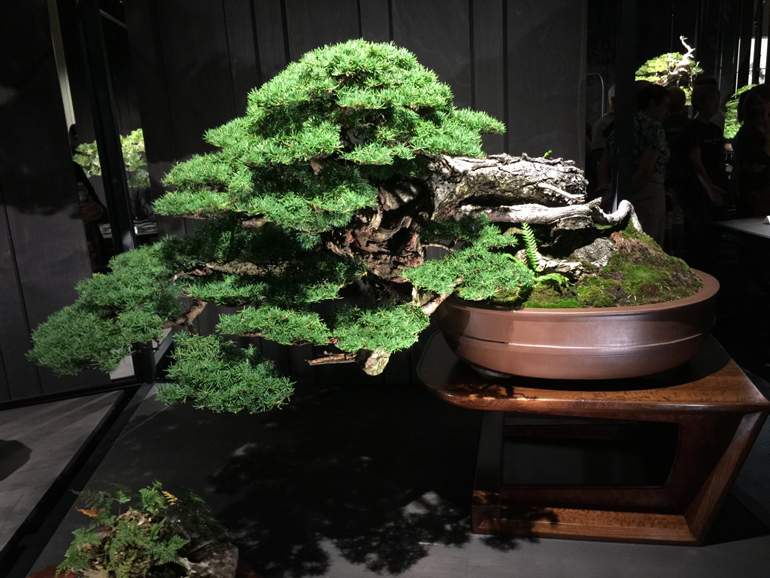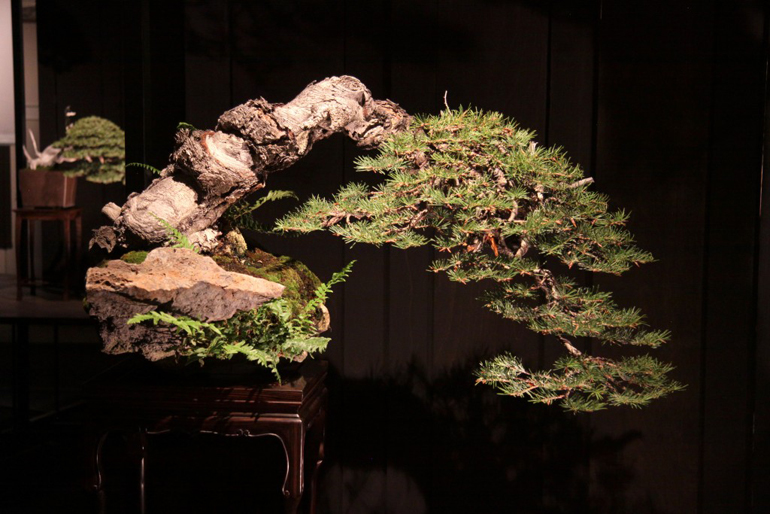
Eric Schikowski’s collected Mountain Hemlock was one of my favorites. It was also Peter Warren's first choice. I borrowed this photo and the one below from Eric Shrader's PHUTU blog.
I was going to give the Cup a rest for awhile until I ran across this thorough, thoughtful and thought provoking article on Eric Shrader’s PHUTU (one of the best blogs I’ve had the good fortune to stumble upon lately).
We’ll start with a disclaimer two disclaimers: First, what follows takes nothing away from the winners. All four (third place was a tie) are great bonsai and worthy of accolades. Second, the opinions below are mine and not Eric Shrader’s.
The PHUTU post is about judging bonsai in general and specifically at the Artisans Cup. Rather than repeat everything Eric has to say, I’ll just add a couple remarks and encourage you to visit PHUTU.
The most striking thing I came away with is, each of the six judges had their own top ranked tree and NONE of these placed in the top four finishers.*
This may be a once-in-a-lifetime statistical anomaly, but even if it is, it doesn’t erase the suspision that the point system, though useful as a learning tool, doesn’t always work if you want to find the most interesting, beautiful, unusual, or worthy bonsai (or medium or small or non-coniferous bonsai in this case).
It’s possible that no judging system really works, or at least would satisfy skeptics. However there may be a more intuitive system that just might produce better results than the point system (we’ll save this for tomorrow’s post).

Here's another one that was in my intuitive top tier. It's Doug Paul's Doug fir that was Colin Lewis' first choice.
Here’s a quote by Walter Pall, one of the judges at the Cup. Borrowed from PHUTU’s comments:
“I agree to most everything you are saying. Modern Bonsai has finally fully arrived in America. In this style it is most important to impress the viewer with whatever means. The monster conifers have the most talent for this. Quiet, more classical and zenny trees should be there but will by definition not score high. Loud scores high. You don’t have to like it, just understand.”
*”Peter Warren awarded top marks to Eric Schikowski’s collected Mountain Hemlock. David Degroot awarded the high score to two trees: The large Japanese Black Pine from the Pacific Bonsai Museum and Jim Gremel’s field-grown ‘Kishu’ Chinese juniper. Colin Lewis gave top prize to Doug Paul’s collected Rocky Mountain Douglas Fir. Walter Pall was most impressed by Bob Shimon’s collected coast redwood. And Boon picked Eric Schikowski’s collected mountain hemlock.” Lifted directly from Phutu.
I’m having trouble figuring out how to talk about this topic without sounding like a hater. Let me add a little bit here.
The idea that you should drop the high and low scores is based in a fundamental distrust of your judges/scorers. It assumes that fluke scores happen, and should be disregarded.
This is VERY different than assuming that your judges/scorers are experienced and expert. It is very different that allowing them to have different criteria and weighingt on those criteria that can produce different extremes.
The former leads us to believe that the extreme scores do NOT contain valuable information. But if you go through the latter line of reasoning, then there IS valuable information in those scores and it shoudl not be disregarded.
Yes, I am saying that the practice of dropping high and low scores is misapplied when you believe you have expert judges (or well trained judges). It is incredibly disrespectful to the judges. In this case, in which Ryan and Chelsea were so proud of the judges they selected and the procedures they designed, there is no line of reasoning of logic that follows from that to the dropping of high and low scores.
Instead, TAC should have followed another common practice. They should have kept all five scores, and then dropped the high and low to break ties.
Keep posting on this topic (i.e., scoring) and I’ll keep commenting. I study scoring and assessment as a big piece of my professional work and will probably take up every opportunity to try to apply what we actually know from that field to bonsai exhibition scoring.
As a judge at scores of bonsai events and one honored to join the other judges at the Artisans Cup, I can assure you that all judges agree the rubric used was the most efficient, most equitable and most accurate system of multiple judging possible. Any “intuitive” system you refer to leads to subjectivity, whereas in the points system each exhibit must be assessed independently based entirely on its own merits. The disparity of scores reflects the diversity of the judges, which was intentional in order to have as broad a spectrum of opinion as possible. And it worked, right?
Hi Colin,
Thanks for your input. It’s always good to hear from you and I’m sure you are right. Standards, like the point system, are no doubt helpful. Though there are biases built in to any system that involves human judgement and one of the biases that might be in the point systems is how little the overall feeling or effect on the viewer is worth. Considering that I have heard and read several places that bonsai is, like all good art, as much about feeling as anything.
I wonder what would happen if point system were say worth 50% and the intuitive, or completely subjective was also awarded 50%.
Thanks Ceolaf,
You don’t sound like a hater.
Further proof that bonsai is an art form the same as any other, inspiring individual opinions, attitudes and judgements. There is no right or wrong – just personal approaches and views.
I’ve often wondered about scoring systems and how they may reward doing things”by the book”, but may not reward evoked visceral wonder.
I am reminded of the work by Architect/Mathematician Christopher Alexander, especially, ‘The Nature of Order: An Essay on the Art of Building and the Nature of the Universe, Book 1 – The Phenomenon of Life’.
He believes that there are certain designs that elevate people, make them feel more alive, and they have common traits that he elucidates in his book. He also bemoans the fact that structures showcasing the architectural trends du jour are the ones that get lauded and awarded, even though they are not very uplifting or inspiring.
Now, having said that, the winning bonsai in competitions are not in any way of the same genre as the non-life-giving architectural pieces Alexander discusses. (In fact, many of the ‘rules’ that Alexander discusses could be seen in these wondrous pieces of living art.) Still, his main point is that the categories used to judge whether something is good or not, may not truly be reflective of what is existentially good and beautiful, but instead reflect what is in vogue (unless one uses his system ;-)).
His point is valid I think, in that it challenges us to examine whether the categories used in judging simply (but with precision) touch on technical ability vs. being categories reflect evoked visceral feelings of beauty, wonder, joy and mystery.
While not scientific study, I have seen award winning trees at shows that are technically perfect (and beautiful!) arouse less interest among visitors than lesser award winning trees that have a je ne sais quoi that makes people stop, take pictures, look from various angles and discuss.
How do *those* types of feelings get captured in a grading system? Perhaps Alexander’s criteria may be able to be adapted for bonsai?
Until that happens, the current system of scoring has great educational value, and it creates a level, relatively objective, though perhaps imperfect, way to judge trees.
It would be like judging between a Picasso and a Rembrandt – Both are superb, so which is better? Personal choice…….
I think the Judges did a marvelous job. There will always be complaints, concerns, extra analysis. This was an open, thoughtfully conducted and carefully executed process. The fact you know it was a success is that people are still talking about it and there is still buzz. I had a tree in the show, a really good tree, it didn’t place but I have no doubts about the process. Sure we can debate normalization, dropping scores to eliminate outliers, judges using the full range of scores available, questions about can you score a show that will satisfy 100% of the people who see it. I will say this, the trees that won were awesome trees, the judging worked, yet there will never be a perfect system of judging. What I like about this is that the results are open and transparent, subject to Monday morning analysis, this is an unusual and refreshing outcome of the Artisan’s Cup.